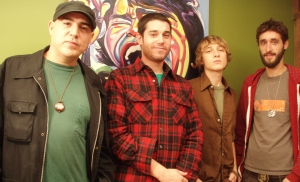Giant Panda Guerilla Dub Squad Interview
Taking their name from a fictional band in a Tom Robbins novel it is clear Giant Panda Guerilla Dub Squad wanted to set themselves out from the crowd. Well fortunately for them, and us, they have done just that.
A groups’ name can be seen as important as the music they create, the ADD generation demand instant gratification, instant reward, so much so the reality is they rarely give music more than 30 seconds to impress them.
GPGDS bassist James Searl tells us why he thinks a band’s name is important.
He said: “Bands find themselves in the schizophrenic position of needing to label themselves and the music they create with a series of letters that go on to form a series of words to set them apart from the rest of the fish in the musical sea of 21st Century music business.
“We do think it is sort of ridiculous, but we have fun with it.”
Fortunately for GPGDS their moniker is one which you will not forget in a while. Even more fortunately for us GPGDS memorable name is backed up by some impressive funky-dub style beats.
As previously stated GPGDS took their name from Tom Robbins ‘Another Attraction’- which is one of the group’s favourite books. The fictional group in the book are called Giant Panda Gypsy Blues Band and Searl says the band in the book “essentially described the band we all wanted to be in.”
“But being more a Guerilla Dub Squad on a musical level, we tweaked the name.”
Formed in the vibrant upstate New York town of Rochester by a close-knit group of friends in the early 2000’s, GPGDS consist of guitarist Dylan Savage, drummer Chris O’Brian, multi-instrumentalist Aaron Lipp and bassist Searl. The group share vocal duties, which comes as a welcome change from so many groups who have one focal point.
Any reggae fan in the US has heard of legendary Long Beach reggae-punks Sublime (now reformed with a new singer) and GPGDS are no different and as with so many others it led individual members to explore other music.
“We listened to tons of Sublime which led us to the dance.
“I saw the Wailers and John Brown’s Body in the same weekend, and the drum and the bass had me more convinced than anything I had ever thought about in my life up to that point.” said Searl.
John Brown’s Body have played a huge role in the GPGDS’s development and Searl now views them as family.
“Getting to know them as people, artists and peers has probably been our greatest claim to actually feeling successful in our careers.
“They are one of our favourite bands to this day and one of our greatest inspirations.”
GPGDS are forging an ever-growing reputation for their live shows, a fact only enhanced by the release of their second album ‘Live Up’ which is made up entirely of live tracks.
Searl is categorical in his defence of the pluses of releasing a live album so early on in their career when asked about it being a risky move.
“We never even thought to think of it like that.
“One of the biggest comments we got from friends and family about ‘Slow Down’ was that it had nothing on our live show.” said Searl.
Searl, perhaps realising the world is not as informed about GPGDS and their live shows as they would like, see ‘Live Up’ as a priority because the music changes so quickly, which Searl says is proof of the diversity the band are capable of creating from night to night.
“I think in the end we will release lots of live material as it happens as well as studio collaborations.”
This raises the possibility that GPGDS could develop a Phish type fan-base with the emphasis on quality live shows, a concept Searl is very open to.
“It was all about playing live and learning how to interpret energy from place to place.
“If we could make people feel as good as Phish made us feel when were at their shows…we would take that in a flash.” said Searl.
The energy which Searl talks off and which is evident in their live album is clearly important to GPGDS and they take care to ensure each show is different.
GPGDS’s music is deeply rooted in the 1970s Jamaican roots scene, artists such as Bunny Wailer, Burning Spear, Lee ‘Scratch’ Perry and of course Bob Marley are all cited by Searl as influences. Other influences show GPGDS’s diverse range of musical tastes with Searl citing Rage Against the Machine, Nirvana, and Radiohead along with some older ‘classic’ rock and jam bands such as The Beatles and The Grateful Dead and the aforementioned Phish.
GPGDS clearly feel the roots sound was not meant to be left in the 70s and they will continue to carry on its tradition while remaining true to themselves and their vision.
Whatever the future holds for GPGDS, whether it is more live albums or studio collaborations, it is a very bright future and one which reggae fans will follow with interest.

Leave a comment